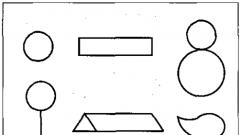Features of the external and internal structure of amphibians on the example of a frog. Frog - a representative of the amphibian class
Like Frogs, one of the most numerous species of amphibians. Features of the external and internal structure of frogs are characteristic of most individuals from this class.
The external structure of the frog
The body of the frog is short, a large flat head without sharp borders passes into the body. Unlike fish, the head of amphibians is movably articulated with the body. Although the frog does not have a neck, it can tilt its head slightly.Two large bulging eyes are visible on the head, protected by eyelids: leathery - upper and transparent movable - lower. The frog blinks frequently, while the moist skin of the eyelids wets the surface of the eyes, protecting them from drying out. This feature has developed in the frog in connection with its terrestrial lifestyle. (Fish, whose eyes are constantly in the water, do not have eyelids.) A pair of nostrils is visible in front of the eyes on the head. These are not only the openings of the olfactory organs. frog breathes atmospheric air, which enters her body through her nostrils. The eyes and nostrils are located on the upper side of the head. When the frog hides in the water, it exposes them to the outside. At the same time, she can breathe atmospheric air and see what is happening outside the water. Behind each eye on the frog's head is a small circle covered with skin. This is the outer part of the organ of hearing - the tympanic membrane. The inner ear of the frog, like that of fish, is located in the bones of the skull.
 The frog has well-developed paired limbs - front and hind legs. Each limb consists of three main sections. In the front leg, there are: shoulder, forearm and hand. In a frog, the hand ends with four fingers (its fifth finger is underdeveloped). In the hind limb, these sections are called the thigh, lower leg and foot. The foot ends with five toes, which in a frog are connected by a swimming membrane. The parts of the limbs are movably articulated with each other with the help of joints. The hind legs are much longer and stronger than the front legs, they play leading role when moving. The sitting frog rests on slightly bent forelimbs, while the hind limbs are folded and located on the sides of the body. Quickly straightening them, the frog makes a jump. The front legs at the same time protect the animal from hitting the ground. The frog swims by pulling and straightening the hind limbs, while the front ones are pressed to the body.
The frog has well-developed paired limbs - front and hind legs. Each limb consists of three main sections. In the front leg, there are: shoulder, forearm and hand. In a frog, the hand ends with four fingers (its fifth finger is underdeveloped). In the hind limb, these sections are called the thigh, lower leg and foot. The foot ends with five toes, which in a frog are connected by a swimming membrane. The parts of the limbs are movably articulated with each other with the help of joints. The hind legs are much longer and stronger than the front legs, they play leading role when moving. The sitting frog rests on slightly bent forelimbs, while the hind limbs are folded and located on the sides of the body. Quickly straightening them, the frog makes a jump. The front legs at the same time protect the animal from hitting the ground. The frog swims by pulling and straightening the hind limbs, while the front ones are pressed to the body. The skin of all modern amphibians is naked. In a frog, it is always moist due to the liquid mucous secretions of the skin glands. Water from environment enters the body of the frog through the skin and with food. The frog never drinks.
frog skeleton
 Unlike fish, frogs have a cervical vertebrae. It is movably articulated with the skull. It is followed by trunk vertebrae with lateral processes (the frog's ribs are not developed). The cervical and trunk vertebrae have superior arches that protect the spinal cord. A long tail bone is placed at the end of the spine in a frog and in all other anurans. In newts and other tailed amphibians, this section of the spine consists of a large number of movably articulated vertebrae.
Unlike fish, frogs have a cervical vertebrae. It is movably articulated with the skull. It is followed by trunk vertebrae with lateral processes (the frog's ribs are not developed). The cervical and trunk vertebrae have superior arches that protect the spinal cord. A long tail bone is placed at the end of the spine in a frog and in all other anurans. In newts and other tailed amphibians, this section of the spine consists of a large number of movably articulated vertebrae. The frog skull has fewer bones than the fish skull. In connection with pulmonary respiration, the frog does not have gills.
The skeleton of the limbs corresponds to their division into three sections and is connected to the spine through the bones of the limb belts. The belt of the forelimbs - the sternum, two crow bones, two collarbones and two shoulder blades - has the form of an arc and is located in the thickness of the muscles. The hind limb belt is formed by fused pelvic bones and is attached tightly to the spine. It serves as a support for the hind limbs.
Internal structure of a frog
muscles
Structure muscular system frogs are much more complex than fish. After all, the frog not only swims, but also moves on land. Thanks to contractions of muscles or groups of muscles, the frog can perform complex movements. Her limb muscles are especially well developed.Digestive system
 Digestive system amphibians has almost the same structure as that of fish. Unlike fish, the hindgut does not open directly outward, but into a special extension of it, called the cloaca. The ureters and excretory ducts of the reproductive organs also open into the cloaca.
Digestive system amphibians has almost the same structure as that of fish. Unlike fish, the hindgut does not open directly outward, but into a special extension of it, called the cloaca. The ureters and excretory ducts of the reproductive organs also open into the cloaca. Respiratory system
 The frog breathes atmospheric air. The lungs and skin are used for breathing. The lungs look like bags. Their walls contain a large number of blood vessels in which gas exchange takes place. The frog's throat is pulled down several times per second, which creates a rarefied space in the oral cavity. Then the air enters through the nostrils into oral cavity and from there to the lungs. It is pushed back under the action of the muscles of the body walls. The frog's lungs are poorly developed, and skin respiration is just as important for it as pulmonary respiration. Gas exchange is possible only with wet skin. If a frog is placed in a dry vessel, its skin will soon dry out and the animal may die. Immersed in water, the frog completely switches to skin respiration.
The frog breathes atmospheric air. The lungs and skin are used for breathing. The lungs look like bags. Their walls contain a large number of blood vessels in which gas exchange takes place. The frog's throat is pulled down several times per second, which creates a rarefied space in the oral cavity. Then the air enters through the nostrils into oral cavity and from there to the lungs. It is pushed back under the action of the muscles of the body walls. The frog's lungs are poorly developed, and skin respiration is just as important for it as pulmonary respiration. Gas exchange is possible only with wet skin. If a frog is placed in a dry vessel, its skin will soon dry out and the animal may die. Immersed in water, the frog completely switches to skin respiration. Circulatory system
 The frog's heart is placed in front of the body, under the sternum. It consists of three chambers: the ventricle and two atria. Both atria and then the ventricle contract alternately. In the frog's heart, the right atrium contains only venous blood, the left - arterial, and in the ventricle the blood is mixed to a certain extent.
The frog's heart is placed in front of the body, under the sternum. It consists of three chambers: the ventricle and two atria. Both atria and then the ventricle contract alternately. In the frog's heart, the right atrium contains only venous blood, the left - arterial, and in the ventricle the blood is mixed to a certain extent. The special arrangement of the vessels originating from the ventricle leads to the fact that only the brain of the frog is supplied with pure arterial blood, while the whole body receives mixed blood.
In a frog, blood from the ventricle of the heart flows through the arteries to all organs and tissues, and from them it flows through the veins into the right atrium - this is a large circle of blood circulation. In addition, blood enters the lungs and skin from the ventricle, and from the lungs back to the left atrium of the heart - this is the pulmonary circulation. All vertebrates, except fish, have two circles of blood circulation: a small one - from the heart to the respiratory organs and back to the heart; large - from the heart through the arteries to all organs and from them back to the heart.
Metabolism
The metabolism of amphibians is slow. The body temperature of a frog depends on the ambient temperature: it rises in warm weather and drops in cold weather. When the air becomes hot, the frog's body temperature drops due to the evaporation of moisture from the skin. Like fish, frogs and other amphibians are cold-blooded animals. Therefore, when it gets colder, the frogs become inactive, and for the winter they completely hibernate.Central nervous system and sense organs
 The forebrain is more developed than in fish, and two swellings can be distinguished in it - large hemispheres. The body of amphibians is close to the ground, and they do not have to maintain balance. In this regard, the cerebellum, which controls the coordination of movements, is less developed in them than in fish.
The forebrain is more developed than in fish, and two swellings can be distinguished in it - large hemispheres. The body of amphibians is close to the ground, and they do not have to maintain balance. In this regard, the cerebellum, which controls the coordination of movements, is less developed in them than in fish. The structure of the sense organs corresponds to the terrestrial environment. For example, by blinking its eyelids, the frog removes dust particles adhering to the eye and moistens the surface of the eye. Like fish, frogs have an inner ear. However, sound waves travel much worse in air than in water. Therefore, for better hearing, the frog also has a middle ear. It begins with the tympanic membrane, which perceives sounds - a thin round film behind the eye. From it, sound vibrations are transmitted through the auditory ossicle to the inner ear.
Reproduction and development of amphibians
Reproductive organs
The reproductive organs of amphibians are very similar in structure to the reproductive organs of fish. All amphibians are dioecious.spawning
After spending the winter in a state of stupor, amphibians wake up with the first rays of the spring sun, and soon begin to breed. Males of some species of frogs croak loudly. Amplification of sounds is facilitated by special bags - resonators, which, when croaking, swell on the sides of the male's head. When breeding, animals split in pairs. Sex cells through the tubular ducts enter the cloaca, and from there they are thrown out. Female amphibians lay eggs similar to fish eggs in the water. Males release a liquid containing spermatozoa onto it.Development
 After some time, the shell of each egg swells and turns into a gelatinous transparent layer, inside which the egg is visible. The upper half of it is dark and the lower half is light: the dark part of the egg makes better use of Sun rays and gets hotter. Lumps of eggs in many species of frogs float to the surface where the water is warmer.
After some time, the shell of each egg swells and turns into a gelatinous transparent layer, inside which the egg is visible. The upper half of it is dark and the lower half is light: the dark part of the egg makes better use of Sun rays and gets hotter. Lumps of eggs in many species of frogs float to the surface where the water is warmer. Low temperature delays development. If the weather is warm, the egg divides many times and turns into a multicellular embryo. After one or two weeks, a frog larva, a tadpole, hatches from the egg. Outwardly, it resembles a small fish with a large tail. The tadpole breathes first with external gills (in the form of small bundles on the sides of the head). Soon they are replaced by internal gills. The tadpole has one circulation and a two-chambered heart; a lateral line is visible on the skin. Thus, amphibian larvae have some structural features of fish.
The first days the tadpole lives at the expense of stocks nutrients eggs. Then a mouth is cut through, equipped with horny jaws. The tadpole begins to feed on algae, protozoa and other aquatic organisms. Further changes in the tadpole go faster than hotter weather. First, his hind legs appear, then the front. The lungs develop. The tadpole begins to rise to the surface of the water and swallow air. The tail gradually shortens, the tadpole becomes a young frog and comes ashore. From the moment of laying eggs to the end of the transformation of a tadpole into a frog, about 2-3 months pass. Frogs, like adult frogs, eat animal food. They can breed from the third year of life.
Frog - typical representative amphibians. On the example of this animal, you can study the characteristics of the entire class. This article describes in detail the internal structure of the frog.
The digestive system begins with the oropharyngeal cavity. A tongue is attached to its bottom, which the frog uses to catch insects. Due to its unusual structure, it is able to be ejected from its mouth with great speed and stick the victim to itself.
On the palatine bones, as well as on the lower and upper jaws of an amphibian, there are small conical teeth. They serve not for chewing, but primarily for holding prey in the mouth. This is another similarity between amphibian and fish. Secret given out salivary glands, moisturizes the oropharyngeal cavity and food. This makes it easier to swallow. Frog saliva does not contain digestive enzymes.

The frog's digestive tract begins with the pharynx. Next comes the esophagus, and then the stomach. Behind the stomach is the duodenum, the rest of the intestine is laid in the form of loops. The intestine ends with a cloaca. Frogs also have digestive glands - the liver and pancreas.
The prey caught with the help of the tongue is in the oropharynx, and then through the pharynx it enters the stomach through the esophagus. Cells located on the walls of the stomach secrete hydrochloric acid and pepsin, which contribute to the digestion of food. Next, the semi-digested mass follows in duodenum, into which the secrets of the pancreas also pour out and the bile duct of the liver flows.
Gradually, the duodenum passes into the small intestine, where all useful substances are absorbed. The remains of food that has not been digested enter the last section of the intestine - a short and wide rectum, ending in a cloaca.
Internal structure frog and its larvae are different. Adults are predators and feed mainly on insects, but tadpoles are real herbivores. Horny plates are located on their jaws, with the help of which the larvae scrape off small algae along with the single-celled organisms living in them.
Respiratory system
Interesting features of the internal structure of the frog also relate to breathing. The fact is that, along with the lungs, an amphibian skin filled with capillaries plays a huge role in the process of gas exchange. The lungs are thin-walled paired sacs with a cellular inner surface and an extensive network of blood vessels.

How does a frog breathe? The amphibian uses valves capable of opening and closing the nostrils and movements of the floor of the oropharynx. In order to take a breath, the nostrils open, and the bottom of the oropharyngeal cavity descends, and the air enters the frog's mouth. In order for it to pass into the lungs, the nostrils close and the bottom of the oropharynx rises. Exhalation is produced by the collapse of the lung walls and the movements of the abdominal muscles.
In males, the laryngeal fissure is surrounded by special arytenoid cartilages, on which the vocal cords are stretched. The high volume of sound is provided by the vocal sacs, which are formed by the mucous membrane of the oropharynx.
excretory system
The internal structure of the frog, or rather, it is also very curious, since the waste products of an amphibian can be excreted through the lungs and skin. But still, most of them are excreted by the kidneys, which are located at the sacral vertebra. The kidneys themselves are elongated bodies adjacent to the back. These organs have special glomeruli that can filter decay products from the blood.
Urine is carried through the ureters to the bladder, where it is stored. After filling the bladder, the muscles near the abdominal surface of the cloaca contract and the fluid is ejected through the cloaca to the outside.
Circulatory system
The internal structure of the frog is more complex than that of an adult frog, it is three-chambered, consisting of a ventricle and two atria. Due to the single ventricle, arterial and venous blood is partially mixed, the two circles of blood circulation are not completely separated. The arterial cone, which has a longitudinal spiral valve, departs from the ventricle and distributes mixed and arterial blood into different vessels.

Mixed blood is collected in the right atrium: venous blood comes from internal organs, and arterial - from the skin. Arterial blood enters the left atrium from the lungs.
The atria contract simultaneously, and blood from both enters the single ventricle. Due to the structure of the longitudinal valve, it enters the organs of the head and brain, mixed - to the organs and parts of the body, and venous - to the skin and lungs. It can be difficult for students to understand the internal structure of a frog. Scheme circulatory system amphibians will help visualize how blood circulation works.
The circulatory system of tadpoles has only one circulation, one atrium and one ventricle, like in fish.
The structure of the blood of a frog and a person is different. have a nucleus oval shape, and in humans - a biconcave shape, the nucleus is absent.
Endocrine system
The frog's endocrine system includes the thyroid, gonads, pancreas, adrenal glands, and pituitary gland. Thyroid produces hormones necessary to complete metamorphosis and maintain metabolism, the gonads are responsible for reproduction. The pancreas is involved in the digestion of food, the adrenal glands help regulate metabolism. The pituitary gland produces a number of hormones that affect the development, growth and color of the animal.

Nervous system
Nervous system The frog is characterized by a low degree of development, it is similar in characteristics to the nervous system of fish, but has more progressive features. The brain is divided into 5 sections: middle, intermediate, forebrain, medulla oblongata and cerebellum. The forebrain is well developed and is divided into two hemispheres, each of which has a lateral ventricle - a special cavity.
Due to monotonous movements and a generally sedentary lifestyle, the cerebellum is small in size. The medulla oblongata is larger. In total, ten pairs of nerves emerge from the frog's brain.
sense organs
Significant changes in the sense organs of amphibians are associated with the exit from the aquatic environment to land. They are already more complicated than those of fish, as they should help to navigate both in water and on land. Tadpoles have developed lateral line organs.

Pain, tactile and temperature receptors are hidden in the epidermis layer. The papillae on the tongue, palate, and jaws function as organs of taste. The olfactory organs consist of paired olfactory sacs that open with both external and internal nostrils to the environment and the oropharyngeal cavity, respectively. In the water, the nostrils are closed, the organs of smell do not work.
As organs of hearing, the middle ear is developed, in which there is an apparatus that amplifies sound vibrations due to the tympanic membrane.
The structure of the frog's eye is complex, because it needs to see both under water and on land. Movable eyelids and a nictitating membrane protect the eyes of adults. Tadpoles have no eyelids. The cornea of the frog eye is convex, the lens is biconvex. Amphibians see fairly far and have color vision.
frogs inhabit in the meadows in moist forests and swamps, as well as along the banks quiet rivers and picturesque lakes. These unique ones are prominent representatives order of tailless amphibians.
The size of frogs depends on the species: European frogs are usually not larger than one decimeter. North American frog - can be twice as large. And the African frog, which is a kind of record holder, reaches a gigantic size of half a meter in size and a weight of several kilograms.

Pictured is a goliath frog
There are also small species of frogs (families narrow-mouthed, or microfrogs), whose length is less than a centimeter.

Pictured is a frog microfrog
External signs groups of frog animals are: a stocky figure, protruding eyes, shortened compared to folding hind limbs, forelimbs, toothless lower jaw, forked tongue and lack of a tail.
Frogs are cold-blooded animals, that is, they have a body temperature that directly depends on the state of the environment. The frog group of amphibious animals is impressive and diverse, including about five hundred species. It is believed that their original habitat was Africa.
With the help of similar devices that nature has provided frogs with, they are able to produce the widest range of sounds. It is an amazing cacophony, and such magnificent concerts are arranged by male frogs, attracting relatives of the opposite sex.

You can learn a lot of interesting and amazing things by watching frogs. In episodes of life, rescue from enemies and other non-standard situations, amphibian frogs sometimes behave extremely unusually. Periodically, the frog sheds its skin, which is not an organ necessary for life, and by eating it continues to live until a new one grows.
domestic frogs often kept in aquariums, trying to be closer to nature. Many frog species bred in scientific laboratories for experiments and biological research.
Food
Insectivorous frogs are predators, eating with pleasure, and small invertebrates. Particularly large ones do not disdain even more impressive prey, some species of animal frogs even ruthlessly devour their own relatives.

Frogs use sticky and long tongue, which deftly catch midges and other living creatures right on the fly. Among the frog species, there are also omnivorous animals that eat fruits with pleasure.
Frogs bring enough benefits to humans, destroying and eating a lot of harmful ones, and. Therefore, many owners of gardens and household plots treat such helpers with great sympathy and create all the conditions for them to breed and live.
Frogs are eaten, making them extremely original dishes that are delicacies and are used for exquisite tables.
Reproduction and lifespan
frogs are breeding, laying eggs in the water, and its number is truly huge and amazing, sometimes reaching up to 20 thousand eggs at a time. Common and pond frogs lay up to hundreds of eggs, which are large lumps. Sometimes females engage in these groups.

Tadpoles hatch from the eggs. These creatures are frog larvae, breathe with gills, can exist and move only in aquatic environment and have a tail. The transformation of eggs into tadpoles takes from 7 to 10 days.
Over time, tadpoles begin to change greatly, go through the stage of metamorphosis, which lasts about 4 months. First, their hind limbs grow, then the front ones, then the tail-rudder disappears, and the tadpoles turn into adults with hallmarks their own type of frog, ready for life on earth. At three years old frogs become sexually mature.

In the photo frog eggs
Measuring the lifespan of frogs is difficult. But according to the data scientific research, using the measurement of the growth of the phalanges of the fingers by season, data were obtained that made it possible to consider that adults are able to live up to 10 years, and taking into account the tadpole stage, up to 14 years.

Appearance
The body of a frog is subdivided into the head, trunk, forelimbs and longer hind limbs (adaptation for jumping). The neck is not outwardly expressed. The forelimb consists of the shoulder, forearm and hand, ending in 4 fingers, the hind limb consists of the thigh, lower leg and foot with 5 - 6 long fingers connected by a thin leathery fold - a swimming membrane (adaptation for swimming). At the base of the first (inner) finger of the male's forelimb there is a swelling - a genital wart, which helps to hold the female during mating.
On the sides of the wide flattened head are large bulging eyes, equipped with inactive - upper and well mobile lower eyelids (open and close the eyelids on a dead frog with tweezers; look at the movement of the eyelids on a living one). Toward the end of the muzzle are paired external nasal openings - nostrils. Behind the eyes, above the corner of the mouth, there is a rounded area of skin stretched over a semi-ossified cartilaginous ring; This is the tympanic membrane that covers the entrance to the middle ear cavity. From the inside to the center of the tympanic membrane is attached to the auditory bone - the stirrup.
In the corners of the mouth, male green frogs have thin folds of skin - vocal sacs, or resonators that inflate when croaking (if you press your finger on the sides of the body of a living male behind the forelimbs, then the resonators inflate in the form of thin-walled spherical swellings).
1 - nostril, 2 - tympanic membrane, 3 - resonator, 4 - dorsal-lateral folds, 5 - cloacal opening
In male brown frogs, small resonators are hidden under the skin; when croaking, they, inflating, lift the skin below the corners of the mouth.
On the sides of the body, frogs of the genus Rana have longitudinal thickenings of the skin - dorsal-lateral folds. From above, at the end of the body, there is an opening of the cloaca.
The ventral side of the body in frogs is light, the dorsal side is darker, of a protective color. In brown frogs, a black stripe runs from the eye back through the eardrum, masking the eye. Soft, thin, rich in mucous glands, the skin is devoid of scales and is very mobile (it is easily pulled away from the body) due to large subcutaneous lymphatic cavities located almost throughout the body.

:
1 - epidermis, 2 - corium, 3 - glandular cells of the skin gland,
4 - muscular cover of the gland, 5 - excretory duct of the skin gland,
6 - pigment cells
The structure of the oral cavity
Cut the joints at the corners of the mouth with scissors, open the oral cavity wide and examine its structure. First of all, the dimensions of the oral cavity and the wide section of the mouth are striking; this facilitates the capture of prey and is important for respiration.
Small homogeneous teeth adhere to the inner lateral surface of the upper jaw; there are no teeth on the lower jaw.

:
1 - teeth, 2 - tongue, 3 - vomer with vomer teeth, 4 - choanae,
5 - translucent eyeball, 6 - opening of the Eustachian tube,
7 - larynx, 8 - resonator hole
Muscular, sticky, forked at the free end, the tongue is attached with its front end to the anterior end of the lower jaw and can be thrown out of the mouth when catching prey. On the palate (the roof of the oral cavity), small bones are clearly visible - vomers with small vomer teeth sitting on them. In front of the vomers are the paired openings of the internal nostrils, or choanae. After inserting the end of the needle into them, make sure that they communicate with the external nasal openings. In the center of the palate, the eyeballs are well translucent; when the eye muscles contract, the eyes can protrude into the oral cavity, helping to push food into the esophagus. Slightly pressing on the eyes from above, see how deeply they can be pressed into the oral cavity. In the depths of the oral cavity, near the jaw joints, there are openings of the Eustachian tubes leading to the middle ear cavity; a needle inserted into the opening of the Eustachian tube exits through the eardrum.
In the fork between the posterior tips of the tongue at the bottom of the oral cavity, a slight elevation with a longitudinal slit is visible - the larynx, formed by paired arytenoid cartilages. Air enters the lungs through the larynx. At the bottom of the mouth near the corners of the mouth, males have small openings leading to resonators. Behind the laryngeal fissure, the oral cavity imperceptibly passes into a wide esophagus.

.
A - cut the skin; B - cut the wall of the body; B - unscrew the walls of the body:
1 - intermaxillary muscles, 2 - muscles of the shoulder girdle,
3 - muscles of the abdominal wall, 4 - abdominal vein; dotted line - cut lines
frog habitat
Frogs live in damp places: in swamps, wet forests, meadows, along the banks of freshwater reservoirs or in water. The behavior of frogs is largely determined by humidity. In dry weather, some species of frogs hide from the sun, but after sunset or in wet, rainy weather, it is time for them to hunt. Other species live in the water or near the water itself, so they hunt during the day.
Frogs feed on various insects, mainly beetles and Diptera, but also eat spiders, terrestrial gastropods and sometimes fish fry. Frogs lie in wait for their prey, sitting motionless in a secluded place.
When hunting, sight plays a major role. Noticing any insect or other small animal, the frog throws out a wide sticky tongue from its mouth, to which the victim sticks. Frogs grab only moving prey.
Figure: Frog tongue movement
Frogs are active in the warm season. With the onset of autumn, they leave for the winter. For example, common frog winters at the bottom of non-freezing reservoirs, in the upper reaches of rivers and streams, accumulating in tens and hundreds of individuals. The sharp-faced frog climbs into cracks in the soil for wintering.
The external structure of the frog
The body of the frog is short, a large flat head without sharp borders passes into the body. Unlike fish, the head of amphibians is movably articulated with the body. Although the frog does not have a neck, it can tilt its head slightly.

Picture: External structure frogs
Two large bulging eyes are visible on the head, protected over the centuries: leathery - upper and transparent mobile - lower. The frog blinks frequently, while the moist skin of the eyelids wets the surface of the eyes, protecting them from drying out. This feature has developed in the frog in connection with its terrestrial lifestyle. Fish whose eyes are constantly in the water do not have eyelids. A pair of nostrils is visible in front of the eyes on the head. These are not only the openings of the olfactory organs. The frog breathes atmospheric air, which enters its body through the nostrils. The eyes and nostrils are located on the upper side of the head. When the frog hides in the water, it exposes them to the outside. At the same time, she can breathe atmospheric air and see what is happening outside the water. Behind each eye on the frog's head is a small circle covered with skin. This is the outer part of the organ of hearing - eardrum. The inner ear of the frog, like that of fish, is located in the bones of the skull.
The frog has well-developed paired limbs - front and hind legs. Each limb consists of three main sections. In the front leg, there are: shoulder, forearm and brush. In a frog, the hand ends with four fingers (its fifth finger is underdeveloped). In the hind limb, these sections are called hip, shin, foot. The foot ends with five toes, which in a frog are connected by a swimming membrane. The parts of the limbs are movably articulated with each other by means of joints. The hind legs are much longer and stronger than the front legs, they play a major role in movement. The sitting frog rests on slightly bent forelimbs, while the hind limbs are folded and located on the sides of the body. Quickly straightening them, the frog makes a jump. The front legs at the same time protect the animal from hitting the ground. The frog swims by pulling and straightening the hind limbs, while the front ones are pressed to the body.
The skin of all modern amphibians is naked. In a frog, it is always moist due to the liquid mucous secretions of the skin glands.
Water from the environment (from reservoirs, rain or dew) enters the body of the frog through the skin and with food. The frog never drinks.
frog skeleton
The frog skeleton consists of the same main sections as the perch skeleton, however, due to the semi-terrestrial lifestyle and leg development, it differs in a number of features.

Pattern: Frog Skeleton
Unlike fish, frogs have a cervical vertebrae. It is movably articulated with the skull. It is followed by trunk vertebrae with lateral processes (the frog's ribs are not developed). The cervical and trunk vertebrae have superior arches that protect the spinal cord. A long tail bone is placed at the end of the spine in a frog and in all other anurans. In newts and other tailed amphibians, this section of the spine consists of a large number of movably articulated vertebrae.
The frog skull has fewer bones than the fish skull. In connection with pulmonary respiration, the frog does not have gills.
The skeleton of the limbs corresponds to their division into three sections and is connected to the spine through the bones of the limb belts. Forelimb belt - sternum, two crow bones, two collarbones and two spatulas- has the form of an arc and is located in the thickness of the muscles. Rear limb belt formed by fused pelvic bones and is attached tightly to the spine. It serves as a support for the hind limbs.
The internal structure of a frog
frog muscles
The structure of the muscular system of a frog is much more complicated than that of a fish. After all, the frog not only swims, but also moves on land. Thanks to contractions of muscles or groups of muscles, the frog can perform complex movements. Her limb muscles are especially well developed.
Digestive system of a frog
The digestive system of amphibians has almost the same structure as that of fish. Unlike fish, the hindgut does not open directly outward, but into a special extension of it, called cloaca. The ureters and excretory ducts of the reproductive organs also open into the cloaca.

Figure: The internal structure of a frog. Digestive system of a frog
Respiratory system of a frog
The frog breathes atmospheric air. The lungs and skin are used for breathing. The lungs look like bags. Their walls contain a large number of blood vessels in which gas exchange takes place. The frog's throat is pulled down several times per second, which creates a rarefied space in the oral cavity. Then the air enters through the nostrils into the oral cavity, and from there into the lungs. It is pushed back under the action of the muscles of the body walls. The frog's lungs are poorly developed, and skin respiration is just as important for it as pulmonary respiration. Gas exchange is possible only with wet skin. If a frog is placed in a dry vessel, its skin will soon dry out and the animal may die. Immersed in water, the frog completely switches to skin respiration.

Figure: The internal structure of a frog. Circulatory and respiratory system frogs
The circulatory system of a frog
The frog's heart is placed in front of the body, under the sternum. It consists of three chambers: ventricle and two atria. Both atria and then the ventricle contract alternately.
In the frog's heart, the right atrium contains only venous blood, left - only arterial, and in the ventricle the blood is mixed to a certain extent.
The special arrangement of the vessels originating from the ventricle leads to the fact that only the brain of the frog is supplied with pure arterial blood, while the whole body receives mixed blood.
In a frog, blood from the ventricle of the heart flows through the arteries to all organs and tissues, and from them it flows through the veins into the right atrium - this systemic circulation. In addition, blood flows from the ventricle to the lungs and skin, and from the lungs back to the left atrium of the heart - this pulmonary circulation. All vertebrates, except fish, have two circles of blood circulation: a small one - from the heart to the respiratory organs and back to the heart; large - from the heart through the arteries to all organs and from them back to the heart.
Metabolism in amphibians on the example of frogs
The metabolism of amphibians is slow. The body temperature of a frog depends on the ambient temperature: it rises in warm weather and drops in cold weather. When the air becomes very hot, the frog's body temperature drops due to the evaporation of moisture from the skin. Like fish, frogs and other amphibians are cold-blooded animals. Therefore, when it gets colder, the frogs become inactive, tend to climb somewhere warmer, and for the winter they completely hibernate.
The central nervous system and sense organs of amphibians on the example of a frog
The central nervous system and sense organs of amphibians consist of the same departments as those of fish. The forebrain is more developed than in fish, and two swellings can be distinguished in it - large hemispheres. The body of amphibians is close to the ground, and they do not have to maintain balance. In this regard, the cerebellum, which controls the coordination of movements, is less developed in them than in fish.

Figure: The internal structure of a frog. Nervous system of a frog
The structure of the sense organs corresponds to the terrestrial environment. For example, by blinking its eyelids, the frog removes dust particles adhering to the eye and moistens the surface of the eye.
Like fish, frogs have an inner ear. However, sound waves travel much worse in air than in water. Therefore, for better hearing, the frog has developed more middle ear. It begins with the tympanic membrane that perceives sounds - a thin round film behind the eye. From it, sound vibrations are transmitted through the auditory ossicle to the inner ear.













